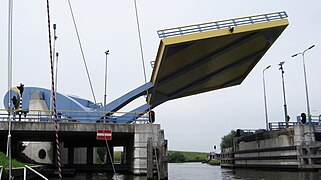The Slauerhoffbrug (English: Slauerhoff Bridge) is a fully automatic bascule bridge (aka tail bridge)[1] in the city of Leeuwarden in the Netherlands. It is a road bridge that carries the Slauerhoffweg (named after J. Slauerhoff) over the Harlingervaart. It was completed in 2000.
The bridge uses two arms to swing a 15×15m section of road in and out of place.[2] The lift arms are oriented diagonally to the road. The bridge is painted in yellow and blue, representative of Leeuwarden's flag and seal.[1] This movable bridge is also known as the “Slauerhoffbrug ‘Flying’ Drawbridge” or Frog Bridge (Dutch: Kikkerbrug), the last because of its shape in the down position. One of the main designers is Emile Asari. A tail bridge can quickly and efficiently be raised and lowered from one pylon (instead of hinges). This allows water traffic to pass while only briefly blocking road traffic.[1]
-
Slauerhoffbrug in down position.
-
Slauerhoffbrug rising.
References
- ^ a b c d Pinkerton, Lindsey (20 February 2009). "Strange Architecture: Bridge Design in the Netherlands". Popular Mechanics. Retrieved 14 August 2011.
- ^ a b c "Van Driel Mechatronica". Retrieved 6 January 2010.
- ^ "Neatorama". Retrieved 6 January 2010.
External links
 Media related to Slauerhoffbrug at Wikimedia Commons
Media related to Slauerhoffbrug at Wikimedia Commons- Popular Mechanics article on the Slauerhoff bridge
- 4 Photos by Van Driel of the bridge up from different angles
- 3 Photos of bridge up
- 1 Photo of bridge up from road
- Slauerhoffbrug opening and closing
- timelapse of the bridge in action











You must be logged in to post a comment.